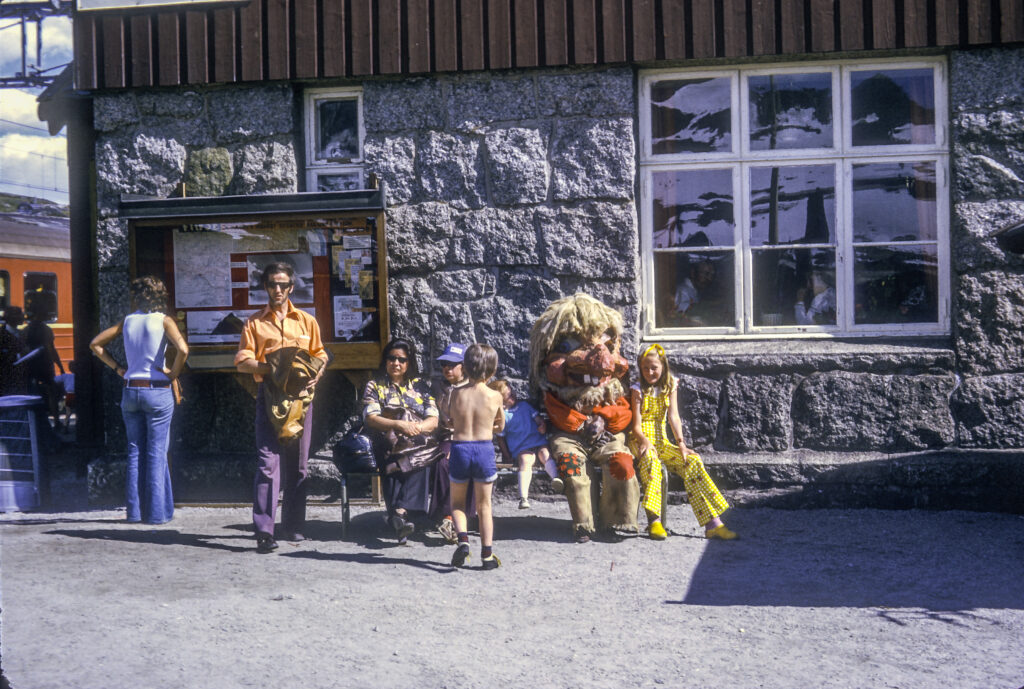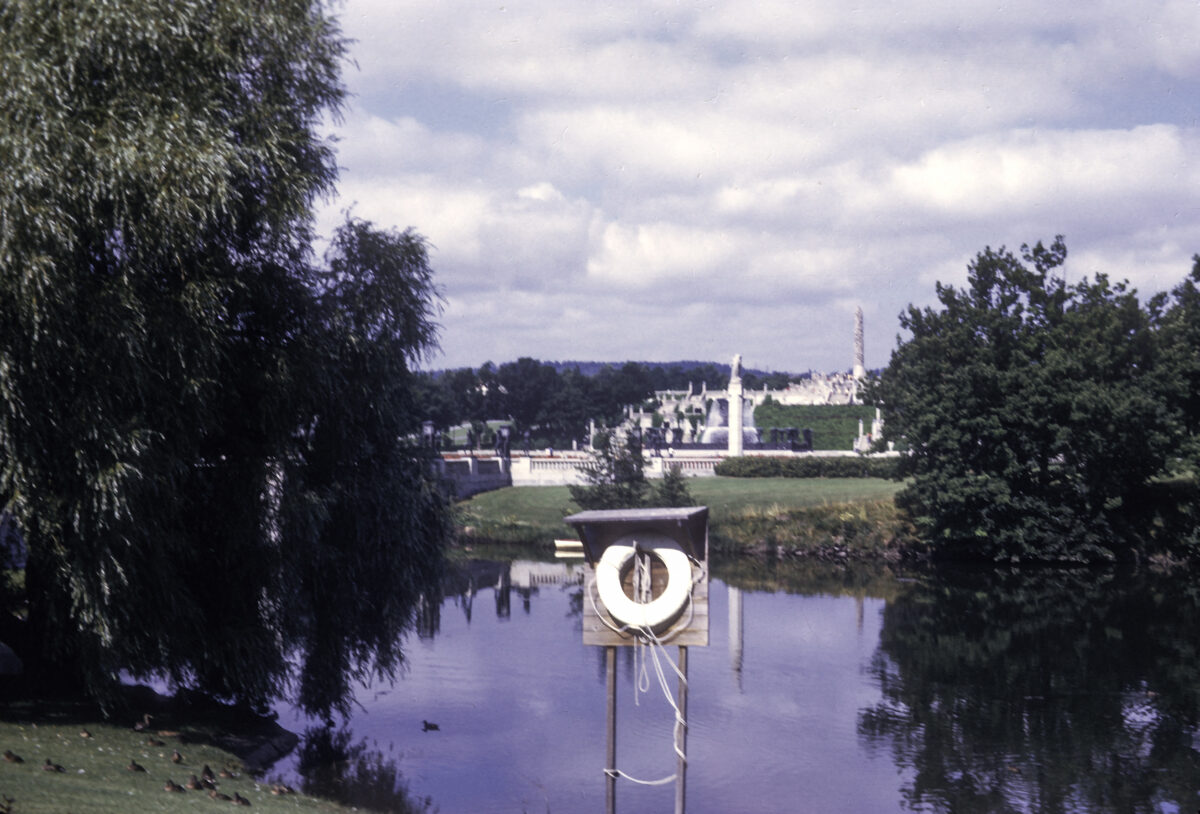I left the Soviet Union in July 1973. Living in the Moscow State University dormitory, I had struck up friendships with a number of visiting foreign students, including several Norwegians. I was not homesick, and I knew I would not have a chance to travel again for a while, so it was perhaps not strange that I decided to prolong my year abroad by making a detour via Norway instead of flying directly home.
My first stop was Oslo, where I stayed with a Norwegian lady named Eva, who showed me around the city. Oslo is of course the capital and largest city in Norway, with a population of over a million. It was founded in the eleventh century, at the end of the Viking Age, when Norway converted to Christianity, and the city celebrated its millenium in 2000.
Eva showed me around the city, taking me first to Frogner Park, the largest park in Oslo and also Norway’s largest tourist attraction. It was originally part of an estate called Frogner Manor, established in the eighteenth century. The manor house still stands and now houses the Oslo Museum. The park is also the location of the Vigeland Sculptures, a collection of 212 granite and bronze sculptures designed by Gustav Vigeland (1869-1943). This encompasses some of the most original and imaginative creations I have ever seen and makes Frogner Park worthy in itself of a visit to Norway.
The sculptures occupy 80 acres of the park and are distributed along an 850-meter (2790 ft.) axis, starting at the main gate on the east. From there one crosses the 15 meter (49 feet) wide Bridge over Frogner Pond to arrive at the Vigeland Fountain, 100 meters (328 feet) west of the gate. The Bridge is lined with 58 statues, the most famous of which is the Angry Boy, depicting a toddler having a temper tantrum. I prefer to call it the “Screaming Spoiled Brat Having a Tizze” statue. Unfortunately, when I photographed it the light came from in back of it, making the Brat’s face difficult to see. You can see a better shot of it in the Wikipedia article on Frogner Park.
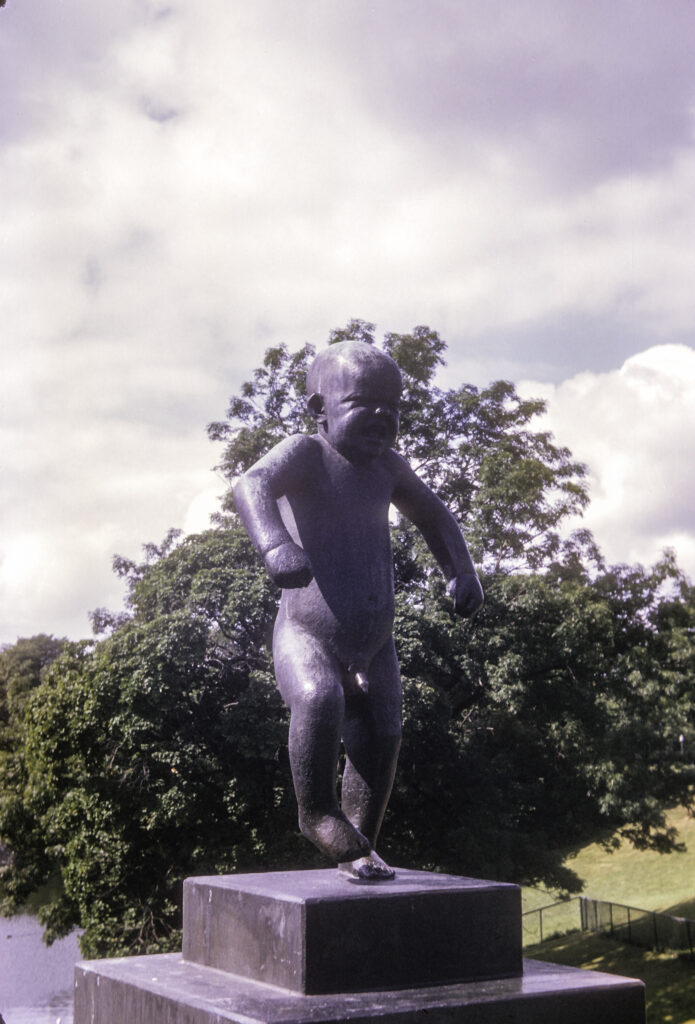
Like the Angry Boy, all the statues in the park depict naked people, both men and women, adults and children. Many of them are engaged in ordinary human activities such as walking, running, dancing, hugging, etc.; but some also represent more abstract conceptions. Some are pensive or placid, others are more animated and dynamic, some are surreal, a few are even violent. The next photo captures the full range: on the left is a group engaged in low-key activities; on the right, a woman dancing and pulling her hair out; behind her, in front of the white column, a man bouncing a small boy on his shoulders; on the column itself, a man fighting a huge lizard.
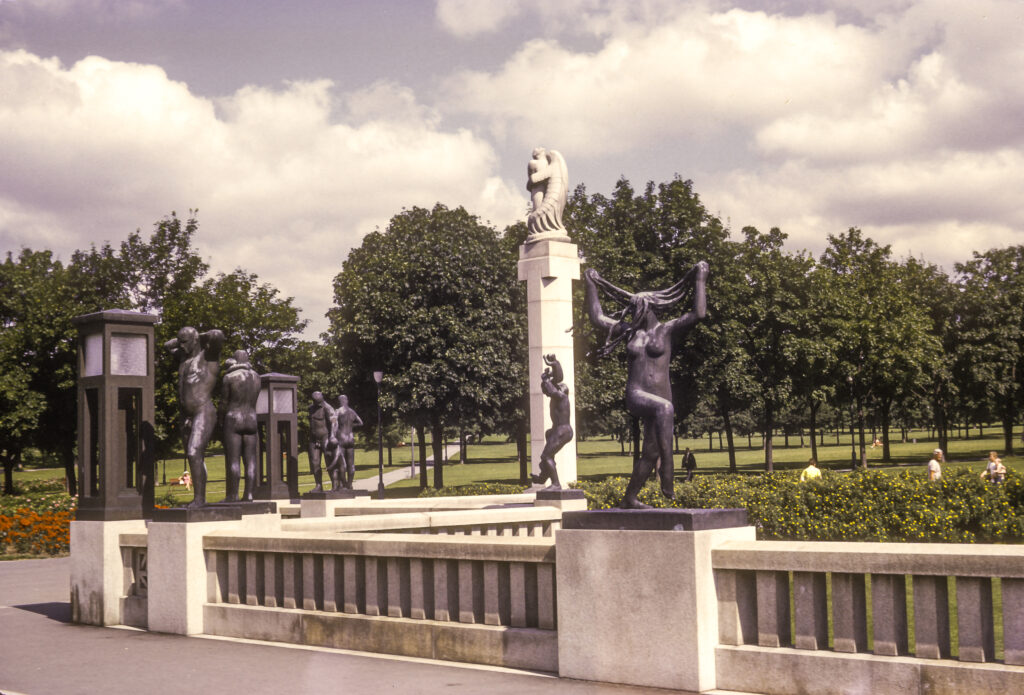
Sometimes I found it hard to figure out what the people depicted by the statues were supposed to be doing. For instance, the girl in the next picture might be swimming, but if so she appears to be doing so in a tree. One web page I came across calls it “Dreams and Flights of Fancy.”
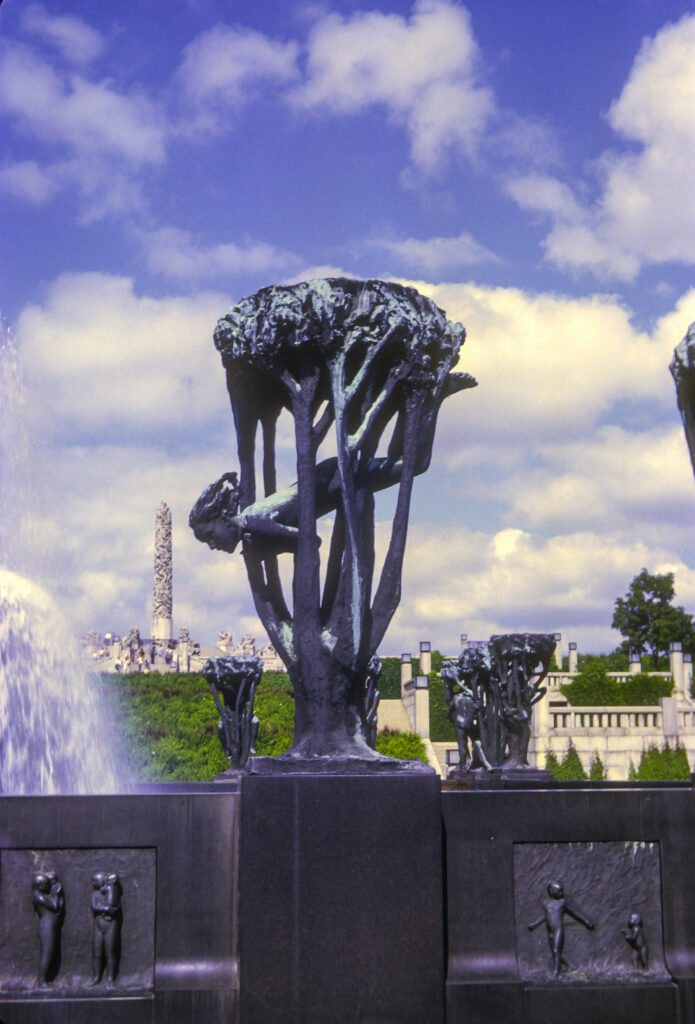
This was just one of 20 sculptures surrounding Vigeland’s Fountain, all depicting people involved with trees. According to the museum’s web page, “The tree groups represent a romantic expression of Man’s relationship to nature. They also form the setting for life’s evolving stages, stretching from childhood and adolescence through adulthood to old age and death.” The Fountain itself is a giant bowl held up by six men, who, according to the fountain’s web page, “representing different ages, may be interpreted as toiling with the burden of life.”
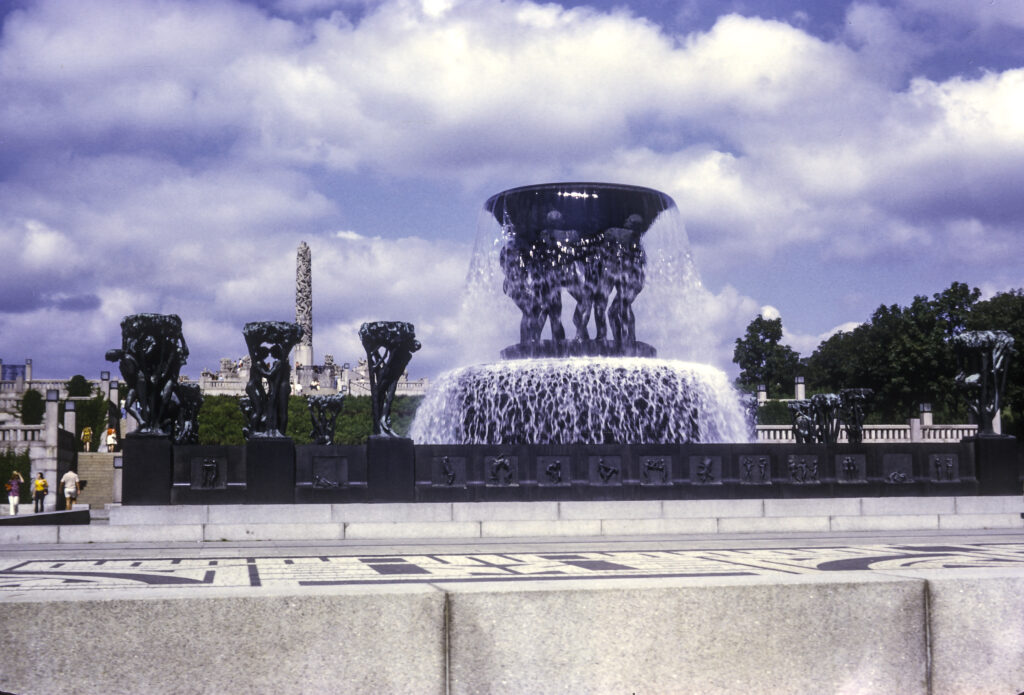
As you can see from the following photo, beyond Vigeland’s Fountain lies the centerpiece of Frogner Park, the Monolith. As you approach the Monolith, you climb a granite staircase festooned with statues of groups of people in all kinds of poses, some rather bizarre.
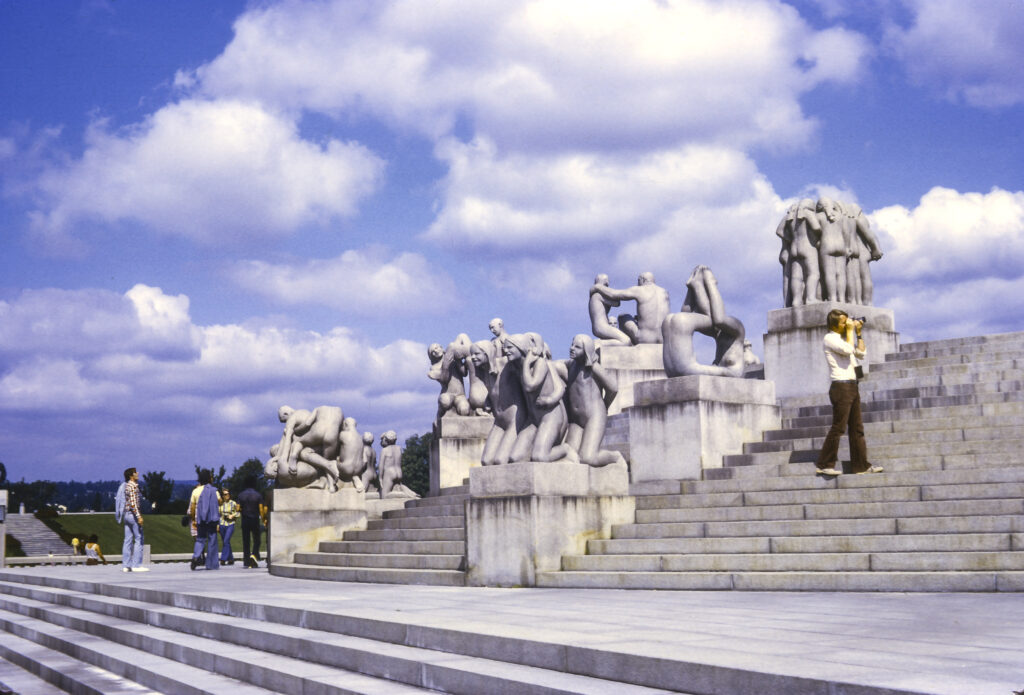
One of my favorites was a woman on her hands and knees, bearing a child on her back. Apparently they are playing horsey, with the child using a braid of the woman’s hair as a bridle, which also serves as a gag, while the child’s expression is one of sadistic delight. It all serves to convey the notion that motherhood turns women into beasts of burden, who are supposed to accept their lot meekly and in silence.
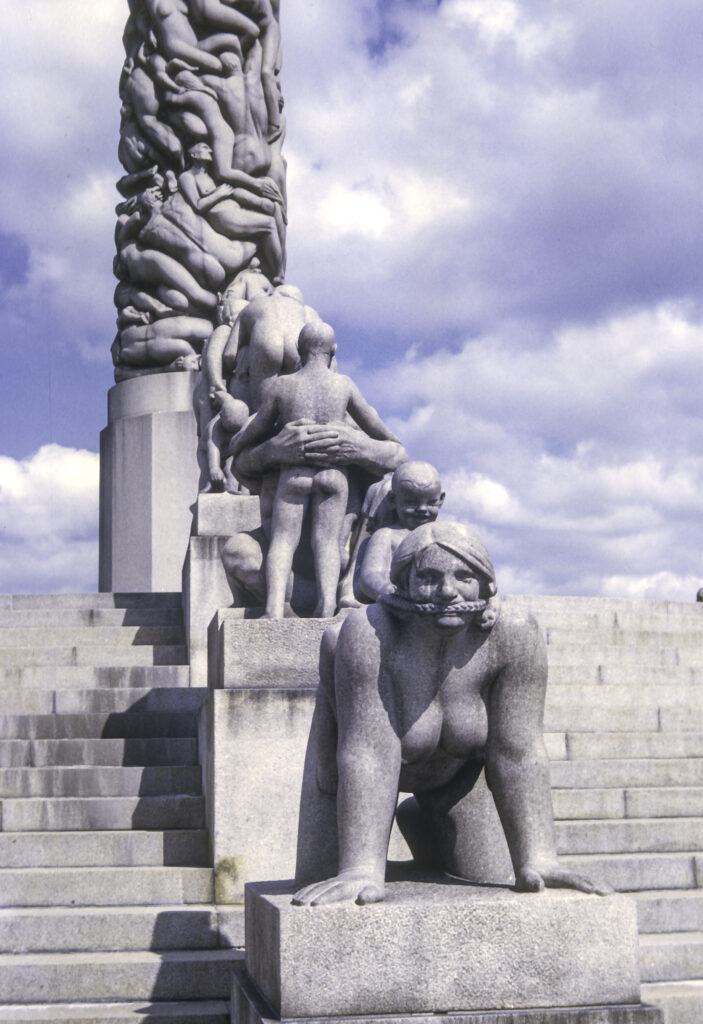
The Monolith towers 46.12 meters – 46.32 feet – over its plaza and resembles a giant granite totem pole, with 121 human figures entwined in it, all seeming to struggle to get to the top.
According to the Vigeland Museum’s Monolith web page, “The sculpture depicts 121 human figures clinging and floating together. There are women and men of different ages, and the top of the Monolith is crowned with children. The sculpture has been interpreted as a kind of vision of resurrection, and our longing and striving for spirituality.”
Vigeland began designing the monolith in 1919 and continued working on it for the rest of his life. Construction actually began in 1927 when a huge granite block was brought to the site and a shed erected over it to protect the workers from the elements. Three stone masons worked on transferring the design from plaster to stone from 1929 to 1943. Vigeland, who died in 1943, did not live to see the unveiling of the Monolith to the public; this occurred in 1944, oddly enough during the Nazi occupation. Apparently the Germans were not hostile to Vigeland’s work, nor he to them, and some critics considered his designs to be an expression of Nazi or Fascist esthetics. Personally, I didn’t find that to be the case.
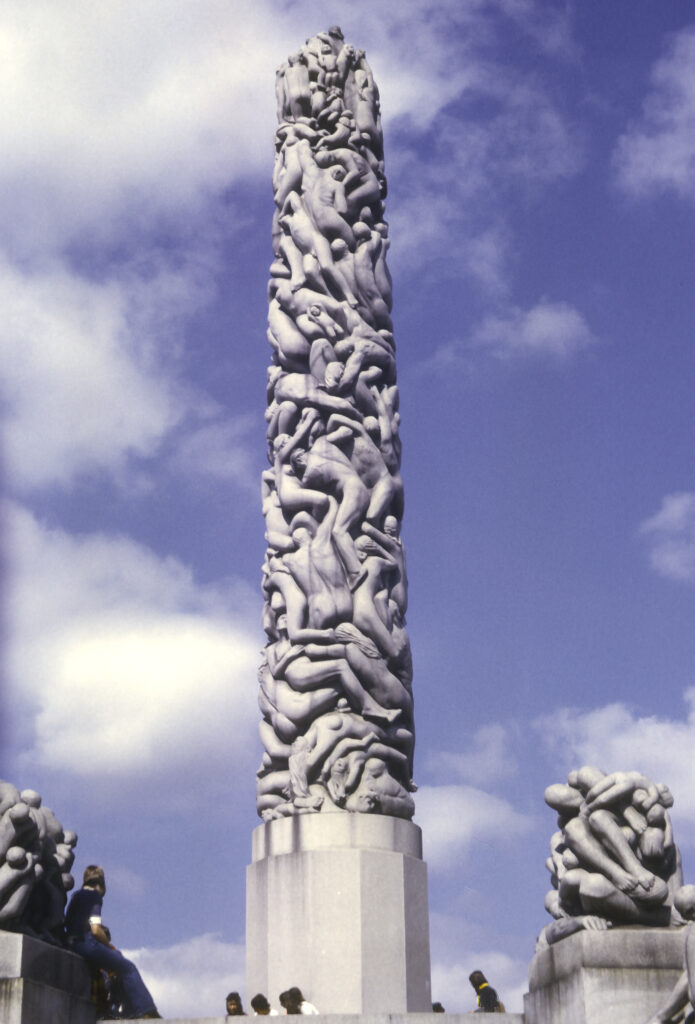
At the west end of the sculpture area stands the Wheel of Life, carved in 1933-34, depicting four adults, a child and a baby linked together in a circle.
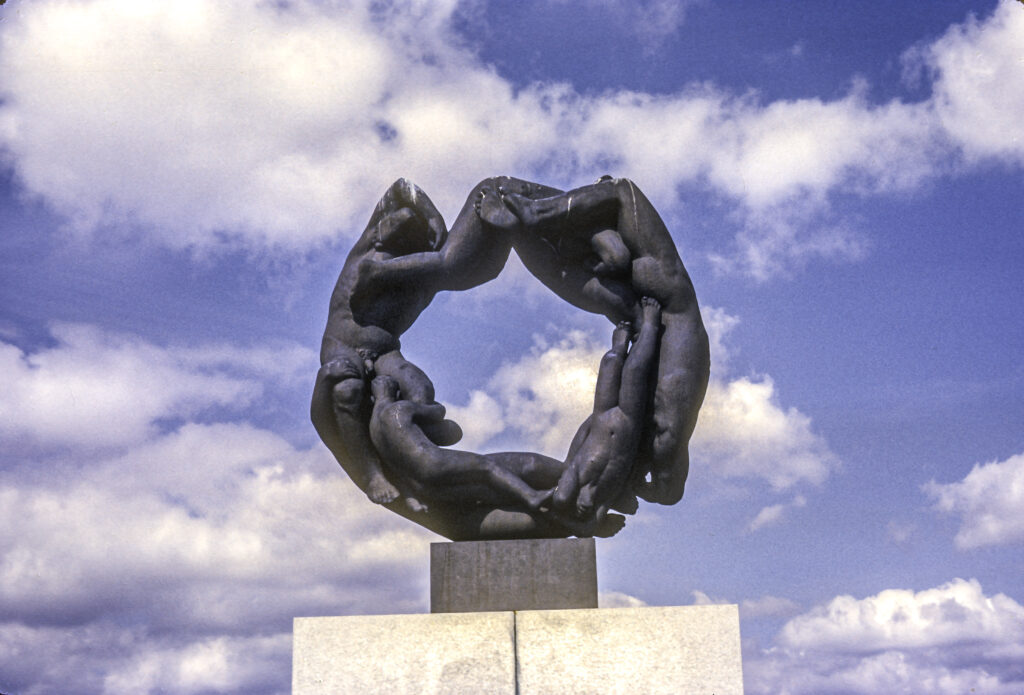
Not very far from Frogner Park, on the Bygdøy peninsula, I visited two fascinating museums, the Vikingskiphuset (Viking Ship Museum) and the Norsk Folkesmuseum, or Norwegian Museum of Cultural History. The former houses three famous Viking-era burial ships, named for the places at which they were excavated – Oseberg, Gokstad and Tune. Because I didn’t have flash equipment, I didn’t take any pictures of the ships, which are housed indoors. But the museum web site has plenty of them.
The Norwegian Museum of Cultural History, however, has a number of outdoor exhibits; in fact it claims to be the world’s first open-air museum, having been founded in 1881. It has extensive collections of artifacts from all regions of the country, including 150 buildings relocated from towns and rural districts. The centerpiece is the Gol Stavkirke, a wooden church originally built in the town of Gol sometime between 1197 and 1216, but disassembled, brought to Oslo and re-erected in 1880. Stave churches, a type of wooden church commonly built in northwestern Europe in medieval times, replaced an older type, the post church, in which the posts – the vertical timbers supporting the walls and roof – were sunk directly into the ground, making them vulnerable to rot and insects, whereas in the stave church the posts rested on stone foundations, affording better protection from decay. I have always been struck by the resemblance between the Norse stave churches and some types of Russian wooden churches such as those at Kizhi, on Lake Onega in Karelia. I wonder whether the similarity is the result of influence or convergent development.
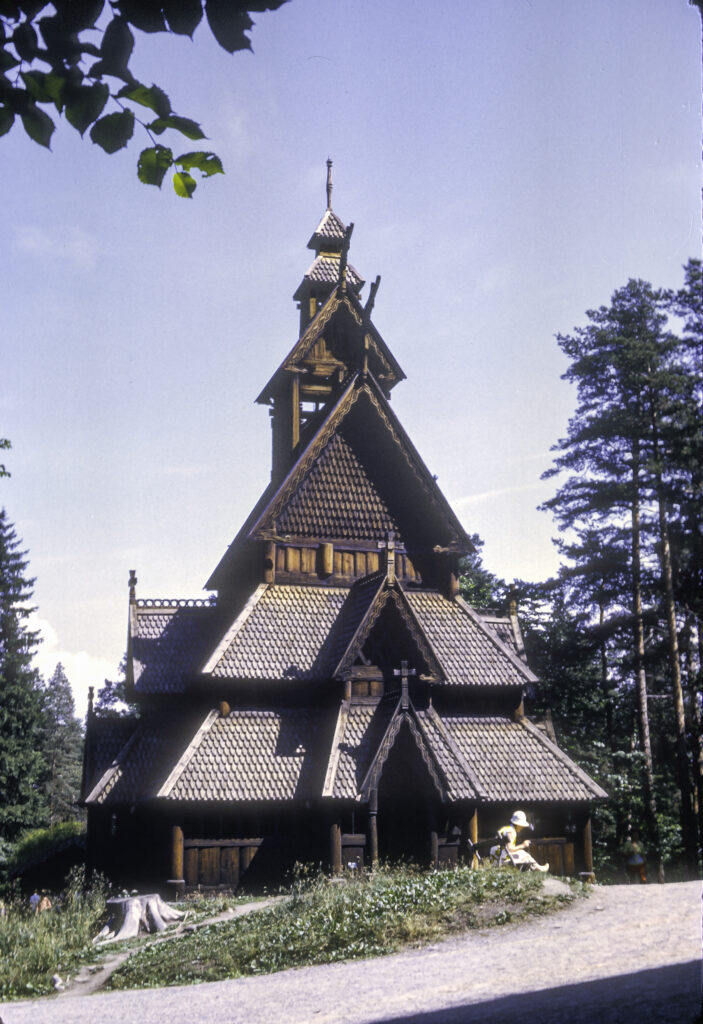
Another legacy of medieval times is the 14th-century Rauland farmstead from Østerdal, consisting of several log buildings as seen in the next photo.
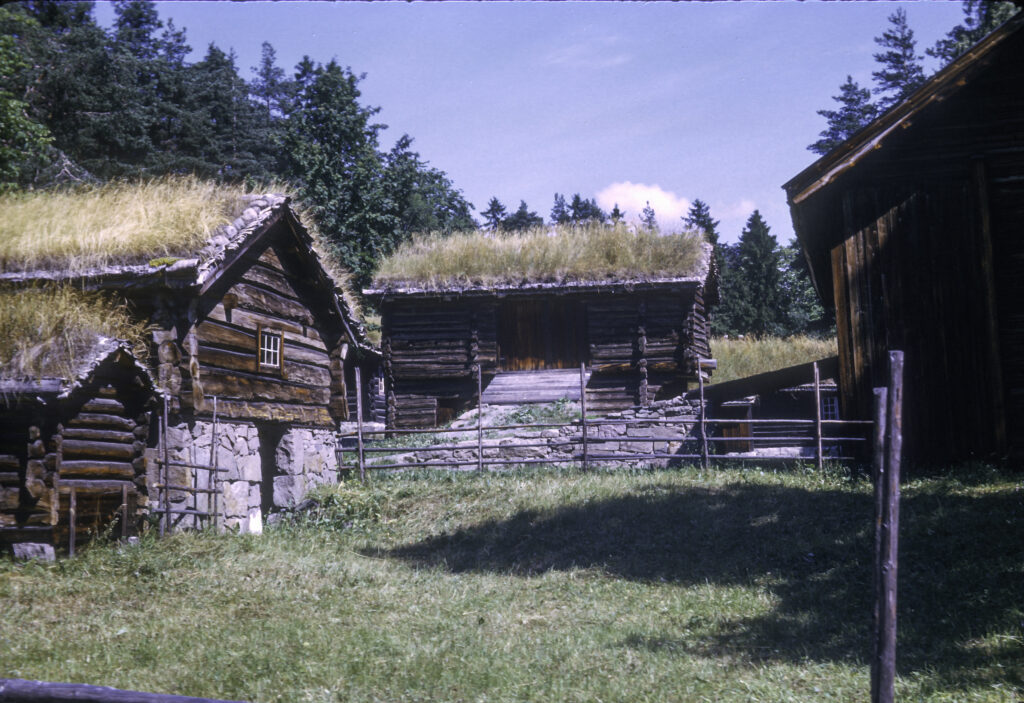
The elegant wooden cabin with its carved balustrade is clearly designed for extreme Nordic weather conditions. The ground floor has a small footprint with sturdy timbers to support the weight of the larger upper floor, which contains the main living quarters and is so designed that in winter, when heavy snowfalls have inundated the ground floor, one can step off the balcony onto the snow wearing skis or snowshoes. The roof is extremely thick and robust in order to withstand huge weights of snow, and slanted to encourage the snow to slide off.
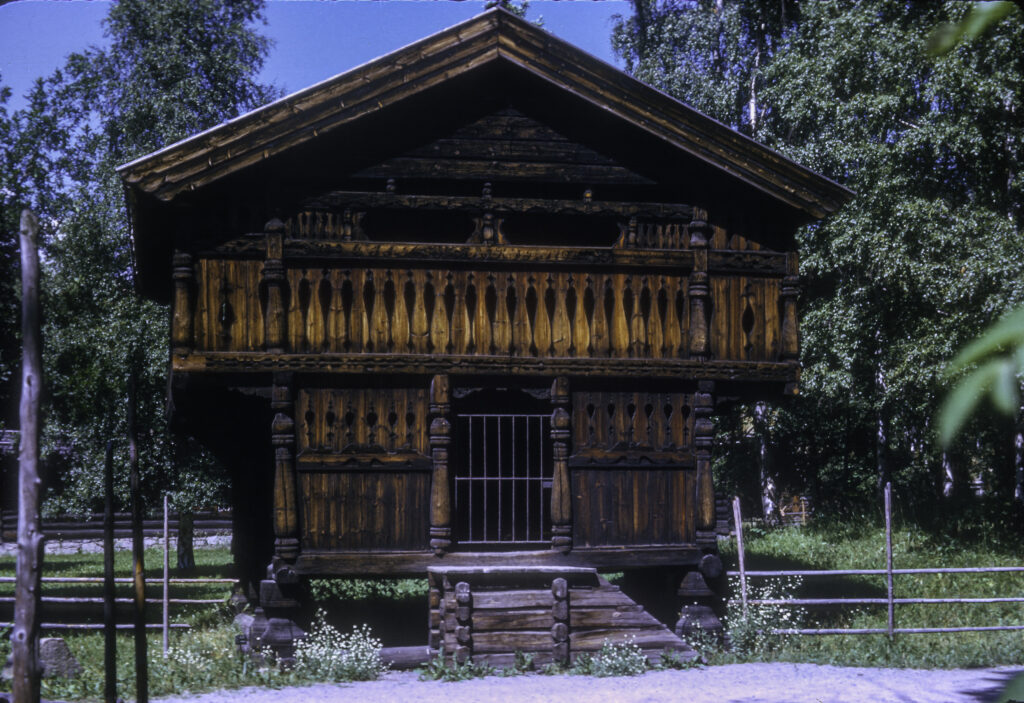
Another set of historical buildings had been transplanted from Hovin and Gransherad, former municipalities in the former county of Telemark. Telemark county is famous for originating a skiing technique that combines elements of Nordic and Alpine skiing. The municipalities are “former” presumably because they have become depopulated, while the county of Telemark is “former” because it has been combined with another county to form the county of Vestfold og Telemark. But this took place only in 2020, long after I visited in 1973. In any case the name Telemark remains forever memorialized in the skiing term.
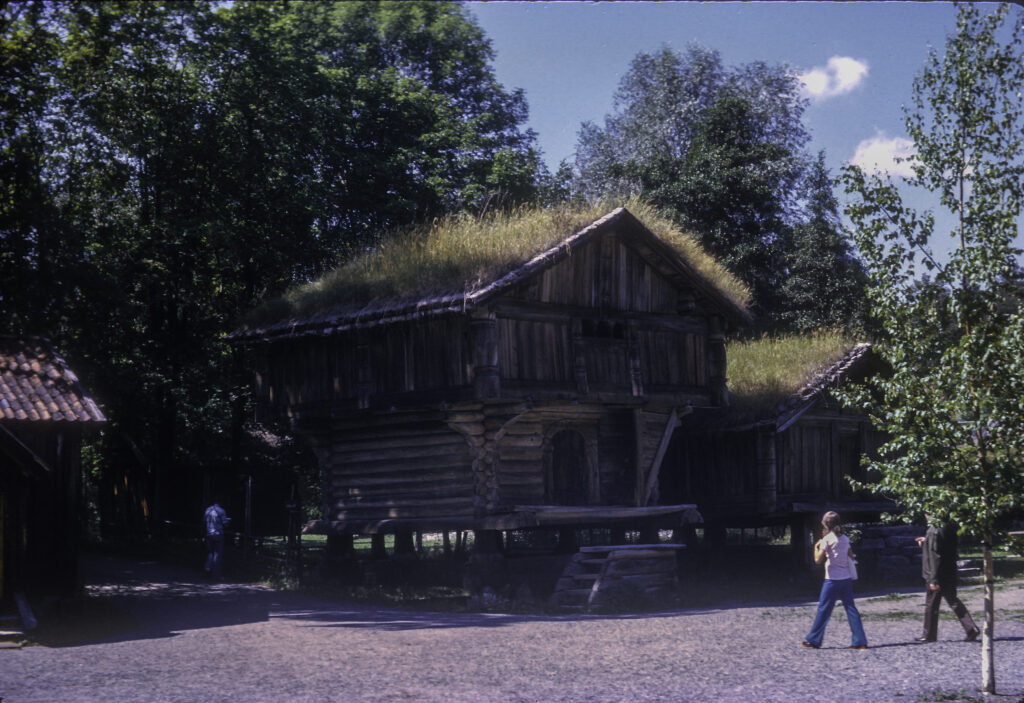
I did not have an opportunity to visit one of Oslo’s most famous historical attractions, the Akershus Festning (fortress). I was only able to snap a photograph of it from across the bay, and the view was obstructed by a stone rampart that I could not climb.
The construction of Akershus Fortress began around 1290, at the order of Norwegian King Haakon V, in the aftermath of an attack on Oslo by a rebel baron and pirate named Alf Erlingsson. Begun as a defensive bulwark, it also came to serve as a royal residence and eventually a prison as well. Its importance soon grew to such a degree that it was said that “Whoever controls Akershus, controls Norway.” Although it doesn’t appear particularly formidable compared to many other famous strongholds I have seen, in the many sieges it has endured over its long history it has never been taken by force. Even the great military genius Charles XII of Sweden failed to capture it. But it surrendered without a struggle to the invading Germans in 1940, when the Norwegian government evacuated Oslo. During World War II, the Germans and their puppet government, headed by the Norwegian traitor Vidkun Quisling, used the fortress as a prison and place of execution for members of the Norwegian Resistance. After the defeat of Germany, the Norwegian Resistance in its turn executed Quisling and other Norwegian traitors, as well as German war criminals, at Akershus. Today it contains two military museums, the Royal Mausoleum and government offices.
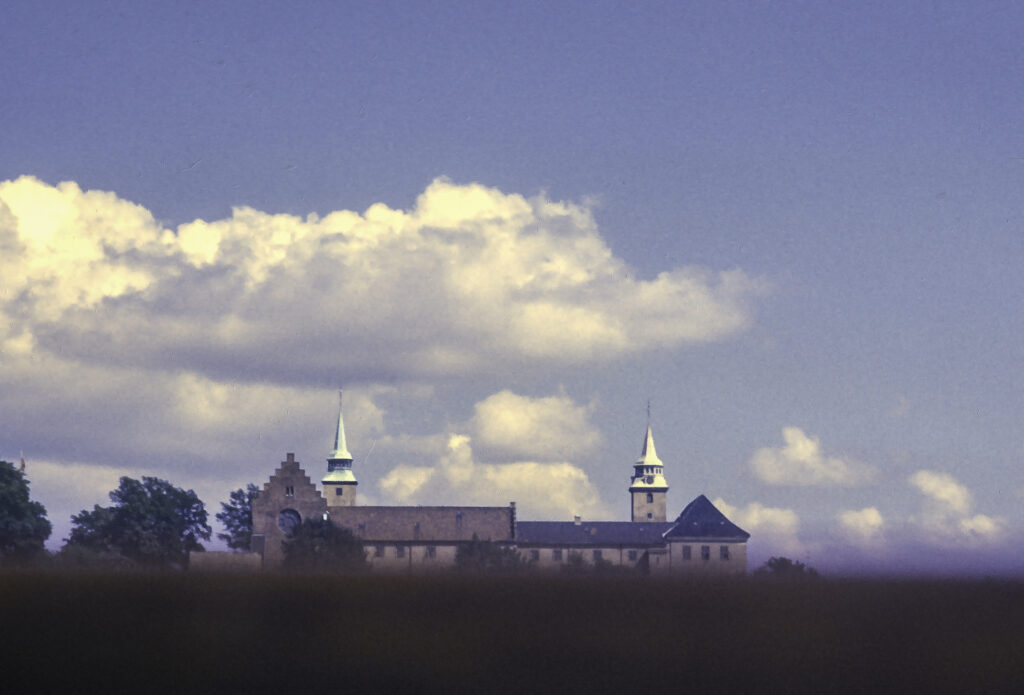
Following my all-too-short stay in Oslo, I went on to Norway’s second-largest city, Bergen, via the Oslo-Bergen Railway, which runs over the rugged snow-covered interior of Norway. My relatively primitive camera allowed me to get only a few pictures from the train, but when it arrived at the halfway point of the journey, the mountain village of Finse, I was able to stroll around a little and get some decent shots of that picturesque hamlet.
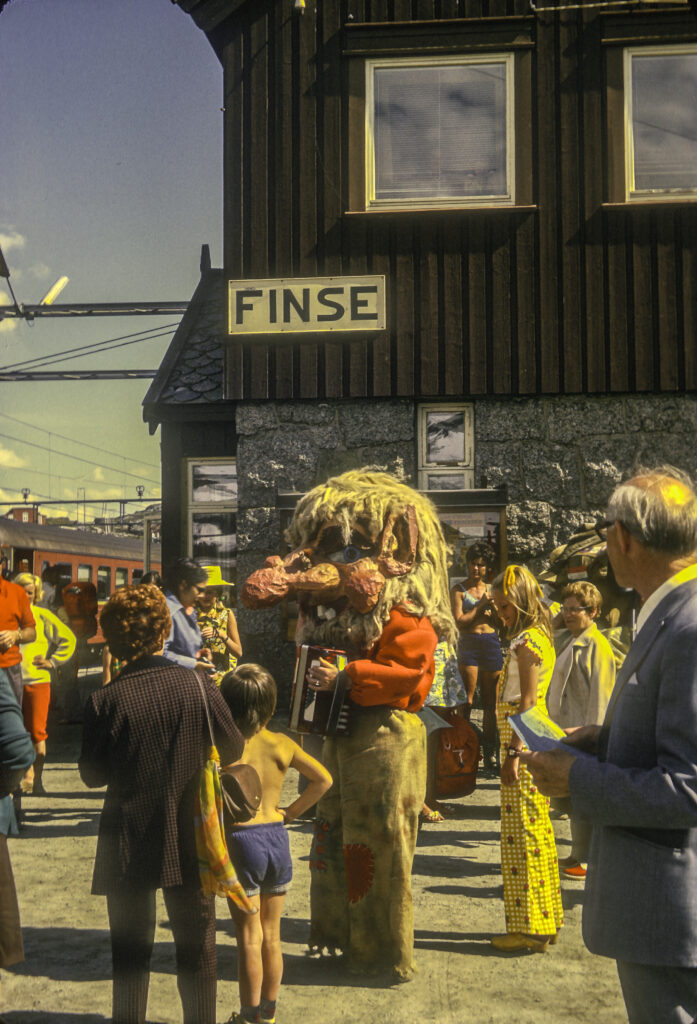
I was enamored of Finse Station, and I suppose one of the major reasons was the railway station’s Troll, who reminded me of the Mountain King in my favorite play, Henrik Ibsen’s Peer Gynt (pace Elouise Mattox). In the play, the callow and foolish title character gets involved with a girl from the Troll community, whom he is to marry, after obtaining permission from her father, the Troll King, who lives in a mountain fastness. In the upshot, Peer arouses the ire of the King by rejecting some of his conditions for the marriage, barely escaping with his life, but not before he has accepted the motto of the Trolls: instead of “To thine own self be true,” which is the human version, the Troll motto is “To thine own self be enough.” This comes back later to haunt him.
Finse sits on the shore of a lake, Finsevatnet, at an elevation of 1,222 meters or 4,009 feet above sea level, the highest point on the Bergen line – or on any Norwegian railway line, for that matter. This doesn’t seem very high compared to the European Alps or the Sierra Nevada in California. In fact my astronomical observatory, in the hills near Anza, California, is higher, at an elevation of 4300 feet, and it rarely snows there. But Finse’s location in the far north ensures that the ground has snow on it the year round.
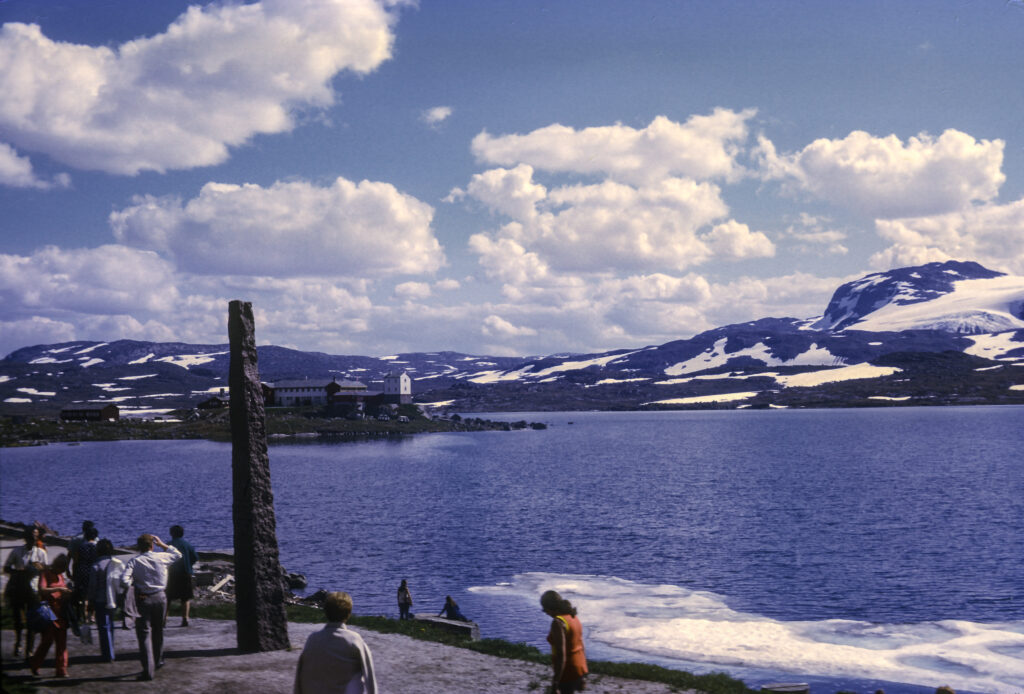
Finse is said to be a Mecca for recreation both in winter and summer. It is also a base for training expedition personnel and first responders. In winter there is snow skiing and iceboat-sailing on the lake; in summer there is hiking, including hiking on the nearby Hardangerjøkulen glacier, and mountain biking. Finse was the location for the shooting of the Hoth ice-planet scenes in Star Wars: The Empire Strikes Back.
Finse also hosts a railway museum. I did not go into the museum, but I did note some of the external exhibits, such as the huge railway cars that were built to serve as snowplows. They had been decommissioned, presumably because they were obsolete; I was not able to find out what had replaced them.
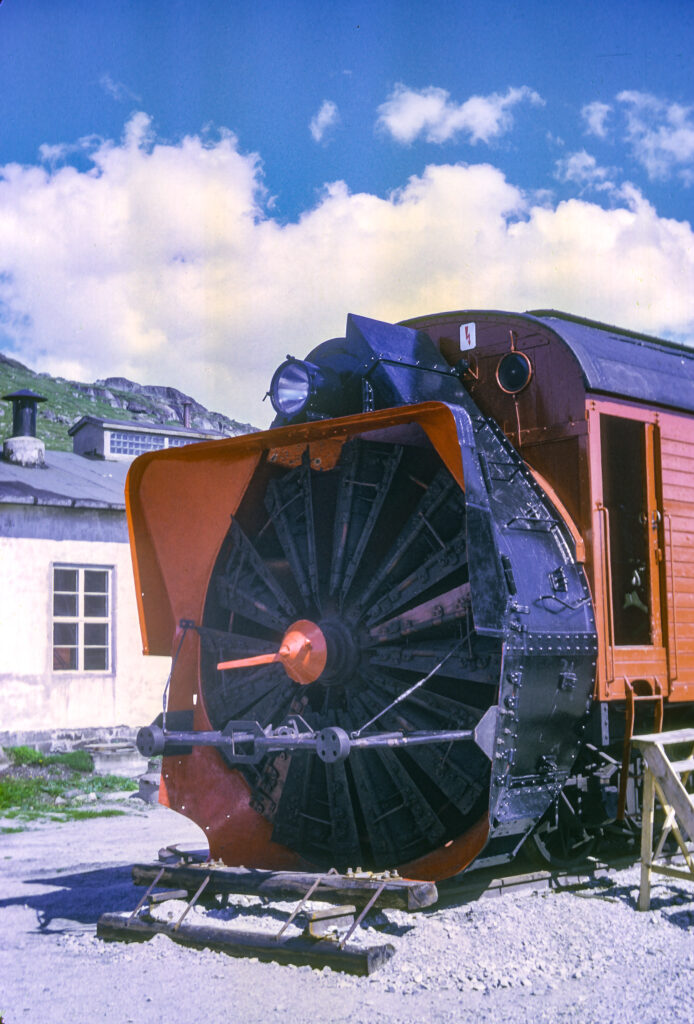
One possible reason was that they were no longer needed, though I found this difficult to believe. It turned out that just west of Finse, a tunnel had been bored through the mountain to reroute the section of the road most prone to blockage by snow and avalanches. The entrance to the tunnel is visible in the next picture.
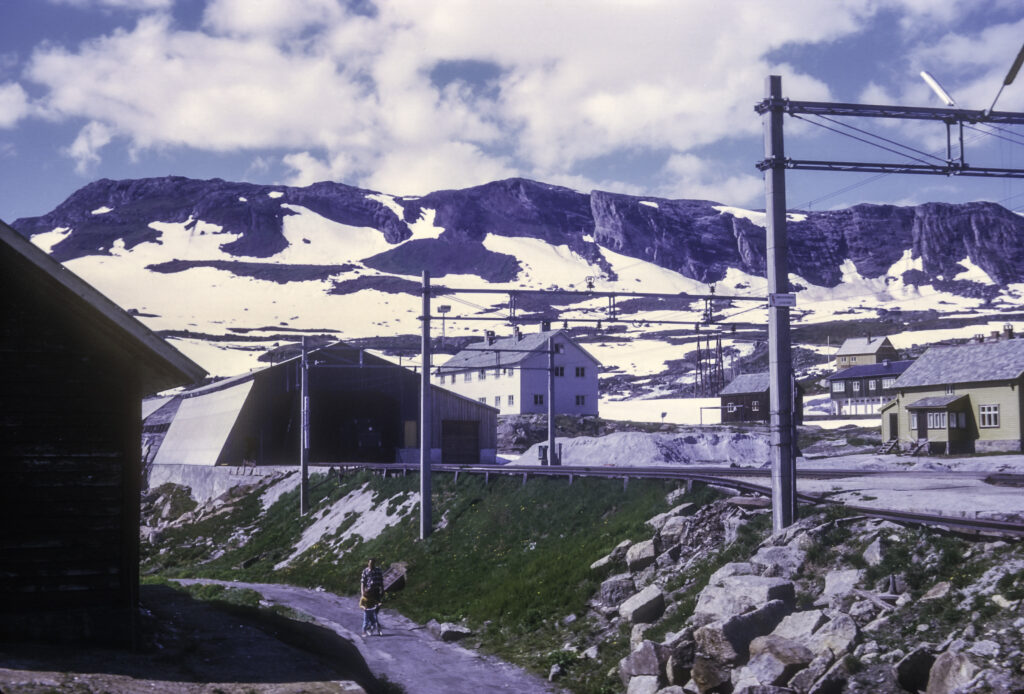
I took my leave of Finse after shooting one last picture of the Troll cavorting with children outside the railway station. I had wanted to wait until he had finished lulling them into complacency, in preparation for seizing them, trussing them up and cooking them for dinner. But the train was leaving, and I had to go.
